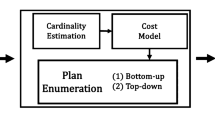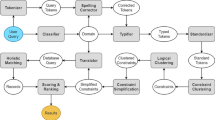Abstract
A set DB of data elements can be represented in terms of its complement set, known as a negative database. That is, all of the elements not in DB are represented, and DB itself is not explicitly stored. This method of representing data has certain properties that are relevant for privacy enhancing applications. The paper reviews the negative database (NDB) representation scheme for storing a negative image compactly, and proposes using a collection of NDBs to represent a single DB, that is, one NDB is assigned for each record in DB. This method has the advantage of producing negative databases that are hard to reverse in practice, i.e., from which it is hard to obtain DB. This result is obtained by adapting a technique for generating hard-to-solve 3-SAT formulas. Finally we suggest potential avenues of application.
Similar content being viewed by others
Abbreviations
- s, y, v::
-
Binary strings
- l::
-
The number of positions in a string
- DB::
-
A set of binary strings, referred to as a positive database
- NDB::
-
A set of strings over {0,1,*}, referred to as a negative database
- NDB (s)::
-
A negative database for the string s. When a specific string is alluded to, its numeric decimal value is used in its place
- NDB A ::
-
A negative database belonging to agent A
- \(\Upsilon\) ::
-
A set of integers indicating bit positions in a string
- m::
-
The number of records in a negative database
- r::
-
The ratio of records to string length in a negative database
- k::
-
Number of specified positions (non “*” symbols) in a string
- c::
-
The number of bits appended to a string. The code length
References
Achlioptas, D., Beame, M.: A sharp threshold in proof complexity. In: STOC: ACM Symposium on Theory of Computing (STOC) (2001)
Achlioptas, D., Gomes, C., Kautz, H., Selman, B.: Generating satisfiable problem instances. In: Proceedings of AAAI-00 and IAAI-00, pp. 256–261. AAAI Press, Menlo Park (2000)
Achlioptas, D., Peres, Y.: The threshold for random k-SAT is 2k log 2–O(k). JAMS: J. Am. Math. Soc. 17 (2004)
Adam N.R. and Wortman J.C. (1989). Security-control methods for statistical databases. ACM Comput. Surv. 21(4): 515–556
Agrawal, D., Aggarwal, C.C.: On the design and quantification of privacy preserving data mining algorithms. In: Symposium on Principles of Database Systems, pp. 247–255 (2001)
Agrawal, R., Evfimievski, A., Srikant, R.: Information sharing aoss private databases. In: SIGMODIC: ACM SIGMOD Interantional Conference on Management of Data (2003)
Agrawal, R., Srikant, R.: Privacy-preserving data mining. In: Proceedings of the ACM SIGMOD Conference on Management of Data, pp. 439–450. ACM Press, New York (2000)
Benaloh, J.C., de Mare, M.: One-way accumulators: a decentralized alternative to digital signatures. In: Advances in cryptology— EUROYPT ’93, pp. 274–285 (1994)
Blakley, G.R., Meadows, C.: A database enyption scheme which allows the computation of statistics using enypted data. In: Proceedings of the IEEE Symposium on Research in Security and Privacy, pp. 116–122. IEEE CS Press (1985)
Blum, M., Goldwasser, S.: An efficient probabilistic public-key enyption scheme which hides all partial information. In: Blakely, G.R., Chaum, D. (eds.) Advances in cryptology: proceedings of CRYPTO 84, Lecture Notes in Computer Science, vol. 196, pp. 289–302. Springer, Berlin, Germany/Heidelberg, Germany/London, UK/etc. (1985)
Camenisch, J., Lysyanskaya, A.: Dynamic accumulators and application to efficient revocation of anonymous edentials. In: Yung, M. (ed.) Advances in cryptology—CRYPTO’ 2002, Lecture Notes in Computer Science, vol. 2442, pp. 61–76. International Association for cryptologic Research, Springer, Berlin (2002)
Chin F. (1986). Security problems on inference control for sum, max and min queries. J. ACM 33(3): 451–464
Cook, S.A., Mitchell, D.G.: Finding hard instances of the satisfiability problem: a survey. In: Du, D., Gu, J., Pardalos, P.M. (eds.) Satisfiability Problem: Theory and Applications, Dimacs Series in Disete Mathematics and Theoretical Computer Science, vol. 35, pp. 1–17. American Mathematical Society (1997)
Denning D. (1982). Cryptography and Data Security. Addison-Wesley, Reading
Denning D. and Schlorer J. (1983). Inference controls for statistical databases. Computer 16(7): 69–82
Denning D.E., Denning P.J. and Schwartz M.D. (1979). The tracker: a threat to statistical database security. ACM Trans. Database Syst. 4(1): 76–96
Denning D.E. and Schlorer J. (1980). A fast procedure for finding a tracker in a statistical database. ACM Trans. Database Syst. 5(1): 88–102
Dobkin D., Jones A. and Lipton R. (1979). Secure databases: Protection against user influence. ACM Trans. Database Syst. 4(1): 97–106
Esponda, F.: Negative representations of information. Ph.D. thesis, University of New Mexico (2005)
Esponda, F., Ackley, E.S., Forrest, S., Helman, P.: On-line negative databases. In: Proceedings of ICARIS (2004)
Esponda F., Ackley E.S., Forrest S. and Helman P. (2005). On-line negative databases (with experimental results). Int. J. Unconv. Comput. 1(3): 201–220
Esponda, F., Forrest, S., Helman, P.: Enhancing privacy through negative representations of data. University of New Mexico, Technical report (2004)
Esponda, F., Forrest, S., Helman, P.: Negative representations of information. Int. J. Inform. Secur. (2004) (Submitted)
Even, S., Yacobi, Y.: Cryptography and np-completeness. In: Proceedings 7th Colloq. Automata, Languages, and Programming. Lecture Notes in Computer Science, vol. 85, pp. 195–207. Springer-Verlag (1980)
Feigenbaum, J., Grosse, E., Reeds, J.A.: Cryptographic protection of membership lists 9(1), 16–20 (1992)
Feigenbaum, J., Liberman, M.Y., Wright, R.N.: Cryptographic protection of databases and software. In: Distributed Computing and cryptography, pp. 161–172. American Mathematical Society (1991)
Fiorini C., Martinelli E. and Massacci F. (2003). How to fake an RSA signature by encoding modular root finding as a SAT problem. Disete Appl. Math. 130(2): 101–127
Gent, I.P., Walsh, T.: The SAT phase transition. In: Proceedings of the Eleventh European Conference on Artificial Intelligence (ECAI’94), pp. 105–109 (1994)
Goldreich O. (2000). Foundations of cryptography: Basic Tools. Cambridge University Press, Cambridge
Goldwasser S. and Micali S. (1984). Probabilistic enyption. J. Comput. Syst. Sci. 28(2): 270–299
Impagliazzo, R., Levin, L.A., Luby, M.: Pseudo-random generation from one-way functions. In: Proceedings of the twenty-first annual ACM symposium on Theory of computing, pp. 12–24. ACM, New York (1989)
Impagliazzo, R., Naor, M.: Efficient cryptographic schemes provably as secure as subset sum. In: IEEE (ed.) 30th annual Symposium on Foundations of Computer Science, October 30–November 1, 1989, Research Triangle Park, NC, pp. 236–241. IEEE Computer Society Press, 1109 Spring Street, Suite 300, Silver Spring, MD 20910, USA (1989)
Jia, H., Moore, C., Strain, D.: Generating hard satisfiable formulas by hiding solutions deceptively. In: AAAI (2005)
Kautz, H.A., Ruan, Y., Achlioptas, D., Gomes, C., Selman, B., Stickel, M.E.: Balance and filtering in structured satisfiable problems. In: IJCAI, pp. 351–358 (2001)
Li Y., Tygar J. and Hellerstein J. (2005). Private matching. In: Lee, D., Shieh, S., and Tygar, J. (eds) Computer Security in the 21st Century., pp 25–50. Springer, Berlin
Freedman, M., Nissim, K., Pinkas, B.: Efficient private matching and set intersection. In: Advances in cryptology—Euroypt ’2004 Proceedings, LNCS 3027, pp. 1–19. Springer (2004)
Matloff, N.S.: Inference control via query restriction vs. data modification: a perspective. In: on Database Security: Status and Prospects, pp. 159–166. North-Holland, Amsterdam (1988)
Merkle, R.C., Hellman, M.E.: Hiding information and signatures in trapdoor knapsacks. vol. IT-24, pp. 525–530 (1978)
Micali, S., Rabin, M., Kilian, J.: Zero-knowledge sets. In: Proceedings FOCS 2003, p. 80 (2003)
Mitchell, D., Selman, B., Levesque, H.: Problem solving: hardness and easiness—hard and easy distributions of SAT problems. In: Proceeding of (AAAI-92), pp. 459–465. AAAI Press, Menlo Park (1992)
Moskewicz, M.W., Madigan, C.F., Zhao, Y., Zhang, L., Malik, S.: Chaff: engineering an efficient SAT solver. In: Proceedings of the 38th Design Automation Conference (DAC’01) (2001)
Naor, M., Yung, M.: Universal one-way hash functions and their cryptographic applications. In: Proceedings of the Twenty First Annual ACM Symposium on Theory of Computing: Seattle, Washington, May 15–17, 1989, pp. 33–43. ACM, New York (1989)
Odlyzko, A.M.: The rise and fall of knapsack cryptosystems. In: Pomerance, C., Goldwasser, S. (eds.) cryptology and Computational Number Theory, Proceedings of symposia in applied mathematics. AMS short course lecture notes, vol. 42, pp. 75–88. pub-AMS (1990)
Ostrovsky, R., Rackoff, C., Smith, A.: Efficient consistency proofs for generalized queries on a committed database. In: ICALP: Annual International Colloquium on Automata, Languages and Programming, pp. 1041—1053 (2004)
Princeton: zChaff. http://ee.princeton.edu/˜chaff/zchaff.php (2004)
Selman, B., Kautz, H.A., Cohen, B.: Local search strategies for satisfiability testing. In: Trick, M., Johnson, D.S. (eds.) Proceedings of the Second DIMACS Challange on Cliques, Coloring, and Satisfiability. Providence (1993)
Shaw, P., Stergiou, K., Walsh, T.: Arc consistency and quasigroup completion. In: Proceedings of ECAI98 Workshop on Non-binary Constraints (1998)
Tendick, P., Matloff, N.: A modified random perturbation method for database security. ACM Trans. Database Syst. 19(1), 47–63 (1994). DOI http://doi.acm.org/10.1145/174638.174641
Wayner, P.: Translucent databases. Flyzone Press (2002)
Author information
Authors and Affiliations
Corresponding author
Rights and permissions
About this article
Cite this article
Esponda, F., Ackley, E.S., Helman, P. et al. Protecting data privacy through hard-to-reverse negative databases. Int. J. Inf. Secur. 6, 403–415 (2007). https://doi.org/10.1007/s10207-007-0030-1
Published:
Issue Date:
DOI: https://doi.org/10.1007/s10207-007-0030-1




